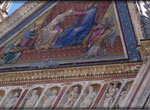Terni Tourism
Orvieto Cathedral
Closer examination
History and ArtFood and WineNature and EnvironmentCongress CentresEvents and AttractionsArchaeological AreasFortresses and CastlesFranciscan Localities
The miracle on the cliff.
Between Heaven and Hell
The San Brizio Chapel, built between 1406 and 1444, opens onto the right wing of the Cathedral transept and is an authentic box within a box. Some of the best Italian artists of the XVth century, were called to Orvieto to fresco the Cathedral walls. Beato Angelico began in 1447 and was then joined by young artists among who Benozzo Gozzoli: together they frescoed two of the four quarters of the vaults and the embellishments of the ribs, and lateral fascia. In 1500, an agreement with Luca Signorelli was finally reached, and he completed the works in five years, from 1499 to 1504 with a cycle of frescos dedicated to the theme of the Apocalypse and the Last Judgement; the stories of the Antichrist, “The End of the World”, “The Resurrection of the Body”, “The Damned”, “The Chosen”, “The Paradise” and “Hell”.
In the distance appear the cliffs of Orvieto. Above the city, kilometres away, the great bulk of the Cathedral can be seen soaring into the sky, and its front can be recognised among the tall spires. Orvieto, the Etruscan Vetzna, Urbs Vetus, the old city, is like a dream, a mirage suspended on the tuff of its cliff. Then the marvellous Gothic face of the Cathedral from time immemorial recognised as one of the most beautiful cathedrals in Europe, decorated with splendid mosaics and intricate bas-riliefs, fascinate its visitors almost as if it were the fulfilment of a miracle. Just like the one where blood flowed from the consecrated host in Bolsena, in whose honour, Pope Urban IVth began the construction work on the Cathedral in 1263.
The “Corporal” of the Bohemian priest protagonist of that miracle is still contained in a chapel in the Cathedral, inside a marvellous Gothic shrine. Among the other chapels, structured with cross vaults, conspicuous for the importance of the picturial cycles preserved in it, is the Chapel of San Brizio where Fra Giovanni da Fiesole, Beato Angelico, Benozzo Gazzoli, the Perugino and, from 1499, Luca Signorelli painted the Frescos dedicated to “The Last Judgement” (Giudizio Universale) and to the Celestial Kingdoms of Heaven and Hell.
The splendour of the mosaics
The face of the Cathedral does not shine only because of the harmony of its forms but also for the gold in its mosaics. A sumptuous and unusual embellishment for the Italian 14th century: mosaics were in fact a form of art diffused mostly in the territories of the Eastern Roman Empire and which can be found in Ravenna, in Italy, the last bastion of Byzantine culture.
The mosaics on the Cathedral front portray a Marion cycle with scenes from the birth of Mary, her wedding, presentation in the temple, and the Annunciation. The apical scene is that of the Coronation set in the central gable. A part of the space dedicated to the mosaics is reserved for the Baptism of Christ, above the left Portal.
Several master glass-makers, painters and mosaicists alternated in the works which began in 1321 and continued until the 18th century. Among these, Lorenzo Maitani, designer and maker of the front itself, under whose direction the embellishments on the tower floors on the fascia and on the cornices were carried out. “The Baptism of Christ” was painted between 1359 and 1360 by Giovanni di Bonino. Frą Giovanni di Leonardello and the Orvietan painter Ugo di Prete Ilario are the creators of the mosaics of the “Annunciation” and of the “Nativity”. The local mosaicist Piero di Puccio di Orvieto worked on the front between 1370 and 1380. In the 16th century, Cesare Nebbia painted the picture of the main frontispiece. The front was finally completed in the 18th century with the “Presentation in the Temple” realised by Giuseppe Ottaviani in substitution of the one by Piero di Puccio. In fact, on occasion of the 500th anniversary of the Cathedral, some of the original mosaics were removed and given to Pope Pio VI. Unfortunately they have almost all been lost. The “Birth of Mary” which survived that unfortunate destiny, is now preserved in the “Victoria and Albert Museum” in London.







